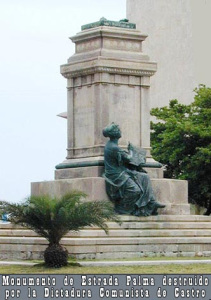Despite the fact that the late Cuban leader Fidel Castro had never paid due respect to any of the Cuban presidents, the one he most despised and criticised was Don Tomás Estrada Palma (1835-1908). Unscrupulously, he had even torn down his statue on the Avenida de los Presidentes in 1961, disregarding the fact that Estrada Palma was one of the most esteemed figures in Cuban history and a close friend of José Martí.

Moreover, Fidel Castro distorted the truth so severely that “Don Tomás”, as Estrada Palma is popularly known in Cuba, has been seen as a truly evil character due to his sincere admiration for the United States as a nation, for its prosperity, the way of life, law-abidance and respect for civil rights.
It has never been acknowledged that the good government of Estrada Palma, who was elected thanks to the support of the whole nation, who loved and respected him, achieved great success for the country thanks to the help of the United States. For instance, when Estrada Palma assumed the presidency, there were half a million dollars in the Cuban Treasury, but four years later, when he retired, there was a surplus of 20 million dollars. It was only thanks to this surplus that all the great improvements in education and industry could have been made; also with regard to the veterans of the War of Independence.
In spite of his belief that annexation to the United States was the best thing for Cuba (he had doubts about there being good leaders on the island), he never proposed anything like this as the only way to go. On the other hand, he did find it desirable to count on American support when fighting a potential civil war or avoiding blood clashes. Such attitude, however, should not be seen as unreasonable or illogical.
Don Tomás lived a fruitful and exemplary life. He and his mother Candelaria were among the first citizens who joined the Cuban War of Independence in 1868. A year and a half later he was taken a prisoner, but he managed to flee to the United States, where he founded, hand in hand with José Martí, the Cuban Revolutionary Party. With power in his hands, he wrote to a friend: “We are going to promote American investments in all kinds of companies on the island in order to develop reciprocal trade between the two countries, thus strengthening the domestic prosperity of Cuba.”
A few days ago, I was struck by the fact that the Granma newspaper published an article in which the President of the Cuban History Institute, René González Barrios, referred to the imprisonment of the eighty-year-old mother of Don Tomás – an event rarely mentioned in the national press before. That made me wonder whether Don Tomás will be eventually rehabilitated, as he deserves.
The Castro regime believed that Estrada Palma’s greatest vice was his desire for re-election and, more importantly, for securing the support of the US government in matters of development, defence and internal stability in the turbulent period of uprisings against the political leadership and administration.
Commenting on this subject, Jaime Suchlicki, famous historian, pointed out that Cubans had been politically irresponsible in that time and that there was a tendency to resolve conflicts using violence. One could thus wonder whether the popular uprising of the liberals that prevented Estrada Palma’s re-election had been a good thing or not.
The rest of the story is known only partially: Estrada Palma resigned as president and months later, he died of pneumonia (or, more likely, of sadness). In the meantime, the tendency of Cubans to resort to violence continued to show, resulting, unfortunately, in a “Revolution” that later turned to a dictatorship that prevailed in the country for decades. In short, political violence in Cuba has never vanished and it’s been some time since it has been used from above.

Leave a comment